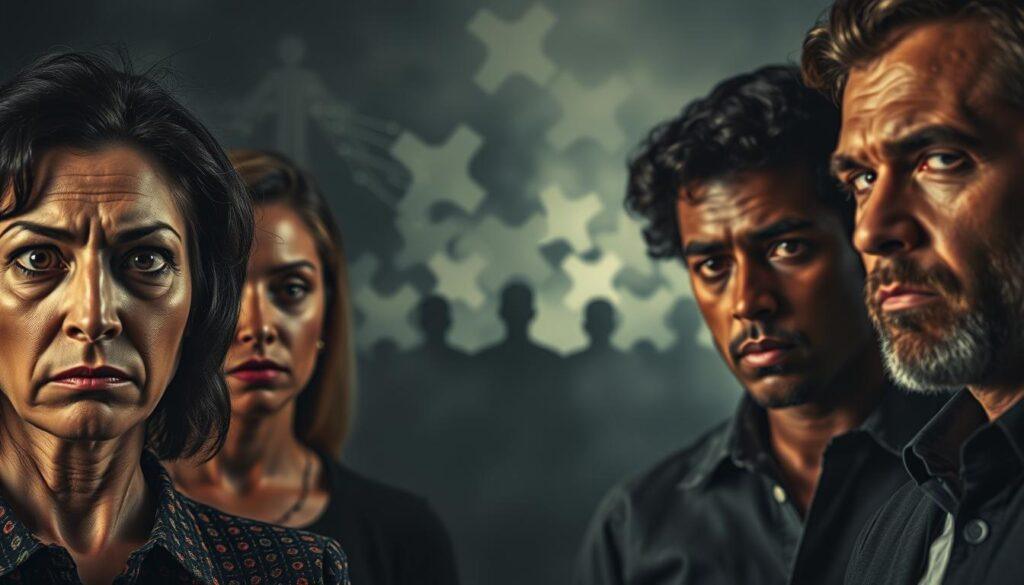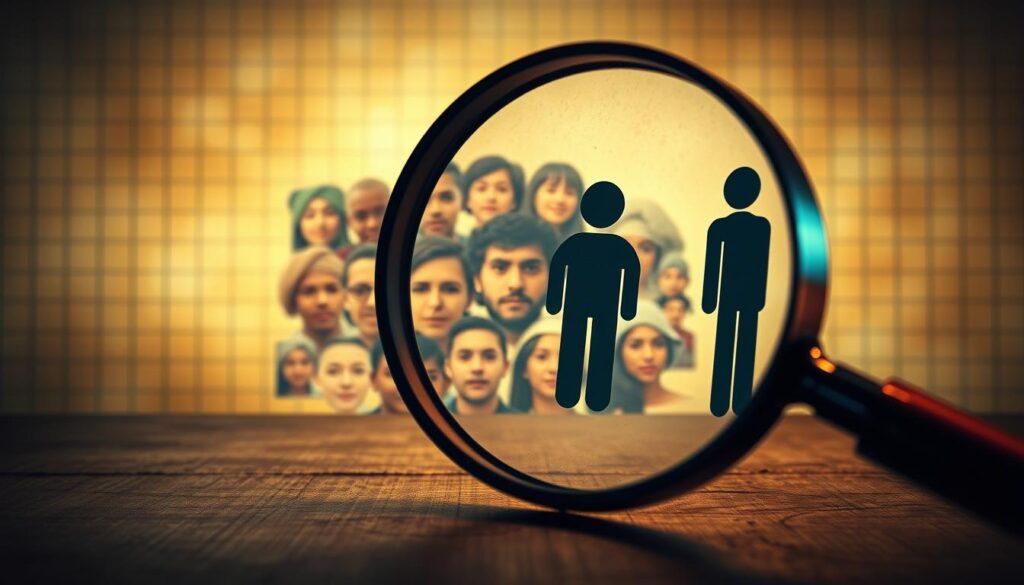Have you ever judged someone based on their group identity without realizing it? The stereotyping mental model is a hidden force that shapes how we view others. It might be influencing your decisions more than you think.
This framework, rooted in psychological constructs, simplifies complex social information into quick judgments. But what happens when those shortcuts become cognitive bias?
Consider this: 36.3% of northeastern Germans faced mental disorders in a year (Asselmann et al., 2019). Yet, only 25.7% of participants believed those with schizophrenia could manage treatment choices (Pescosolido et al., 1999).).
Even 35.5% dismissed people with drug dependence as incapable of making decisions. These gaps show how stereotyping mental models distort perceptions, affecting workplaces and policies.
Key Takeaways
- The stereotyping mental model uses cognitive shortcuts to categorize people, often leading to biased judgments.
- Studies show 25.7% of people underestimate decision-making abilities of those with schizophrenia due to stereotypes.
- Psychological constructs like the Stereotype Content Model (SCM) explain how warmth and competence judgments shape group perceptions.
- Research links higher age to stronger stereotyping tendencies, with 32 out of 33 studies finding a positive association.
- Allyship requires active engagement, not passive labels, as highlighted by Bärí Williams’ work on bias in tech and workplaces.
Understanding the Stereotyping Mental Model
The stereotyping mental model is a way our minds categorize people. It’s based on cognitive psychology and helps us simplify social interactions. But, it can also lead to biases and wrong assumptions.
By looking into its roots and how it differs from other mental shortcuts, we can tackle its impact. This includes how it affects our decisions and interactions with others.
“The stereotyping mental model refers to the internal representations individuals create to simplify and categorize information about people or groups based on perceived characteristics.”
Definition and Core Concepts
Stereotypes act as mental shortcuts in our daily choices. They come from repeated exposure to societal stories. This blends mental model theories into our thinking.
The Stereotype Content Model shows how stereotypes judge others. It uses warmth and competence to shape our first impressions.
Origins in Cognitive Psychology
Our brains use stereotypes as tools, but they can generalize too much. Research shows these shortcuts can lead to biases. For example, over 50% of U.S. adults have prejudices against mental illness.
This shows how deeply stereotypes are ingrained in our society.
How Stereotyping Differs from Other Mental Models
Stereotyping is unique because it combines social categorization with emotional weight. Below, a study shows how demographics affect our perceptions:
| Participant Group | Demographics | Assessment Tools |
|---|---|---|
| Study 1 Participants | 74 university students (43 men, 31 women) | 6-point scale for similarity ratings |
| Ethnicity | 35 Caucasian/White, 24 Asian American/Asian, 9 African American/Black | 12-point scale for mental state inferences |
These findings highlight how culture and experience shape stereotyping. It’s different from neutral shortcuts like heuristics. Stereotyping’s social aspect makes it unique.
Understanding these differences helps us see how stereotypes differ from other constructs. By knowing their origins and differences, we can challenge these models. This leads to more inclusive thinking.
The Psychology Behind Stereotyping
Stereotyping comes from how our brains simplify social info through  . Research in social psychology shows these shortcuts help us process info but can lead to rigid categories. For example, confirmation bias makes us focus on info that confirms our beliefs, ignoring the rest.
. Research in social psychology shows these shortcuts help us process info but can lead to rigid categories. For example, confirmation bias makes us focus on info that confirms our beliefs, ignoring the rest.
A study by Katz and Braly (1933) showed stereotypes stick around. They found people linked racial groups to traits like “lazy” or “industrious.” This shows how prejudice formation starts with early societal norms.
Later, research by Shih et al. (1999) found identity cues affect performance. Asian women did better on math tests when reminded of their ethnicity.
| Study | Year | Key Insight |
|---|---|---|
| Katz & Braly | 1933 | Confirmed racial stereotypes in university students |
| Steele & Aronson | 1995 | Stereotype threat lowers performance under threat conditions |
| Shih et al. | 1999 | Identity cues impact test performance via bias |
Social psychology reveals how “in-group” favoritism creates division. Even positive stereotypes, like thinking women are better at caregiving, hold people back. Our brains seek quick answers, speeding up this process.
Understanding these patterns is the first step to stopping harmful prejudice formation.
How Stereotyping Affects Your Decision Making
Everyday choices, like hiring or trusting others, are influenced by hidden forces. The stereotyping mental model shows how biases, even if not seen, guide our decisions.
These biases, along with social categorization, turn small thoughts into big actions, affecting everything from promotions to healthcare. Let’s dive into how these psychological constructs work.
Unconscious Influences on Everyday Choices
Implicit biases affect our choices without us realizing it. For example, doctors might overlook symptoms in men because of stereotypes about menopause. Social psychology studies show these biases alter how we judge others.
One study found that perceived warmth and fairness are linked, with brain scans showing activity in areas like the lateral OFC during biased choices.
These patterns create cycles where assumptions about groups affect trust and competence. It’s like a self-fulfilling prophecy.
Stereotype Threat and Performance
Feeling judged by a stereotype can lower performance. Stereotype threat causes anxiety, which takes away mental energy and focus. Studies show that professionals from minority groups often face this challenge, with prejudice formation making things worse.
But, using diverse role models can help reduce this effect. Bärí Williams shares a personal experience of feeling pressure to represent their identity in meetings. This shows how identity impacts workplace dynamics.
Social Categorization in Professional Settings
Office dynamics are shaped by social categorization. Being the only one in a group can put a lot of pressure on you. Research shows hiring panels often choose candidates who fit certain molds, ignoring individual talent.
This leads to unfairness in promotions and pay. By understanding these biases, we can work to make decisions based on true ability, not stereotypes.
Common Types of Stereotyping Biases
Everyday choices are influenced by cognitive bias and social categorization, even when we try to be fair. These stereotyping mental model patterns affect workplaces, schools, and communities.
For example, the Minds Matter Report shows how mental health assumptions lead to prejudice formation, limiting care access. Let’s look at how these biases show up:
Gender and Racial Stereotypes
Gender roles like “women are nurturing” and racial stereotypes like “foreigners are untrustworthy” come from social psychology. Bärí Williams, a Black woman in tech, faces challenges to default expectations of competence.
The Implicit Association Test (IAT) shows quick delays when linking “Black” with “success,” proving implicit biases affect hiring and promotions.
Age and Generational Stereotypes
Labels like “millennials are entitled” or “seniors are tech-illiterate” reflect cognitive bias. In 2020, Asian-Americans faced 339% more verbal abuse, according to Stop AAPI Hate data. This shows how crises amplify stereotyping mental model effects.
Even healthcare decisions may favor younger patients unconsciously.
Professional and Social Class Stereotypes
Professions like “CEO = authoritative” or “welfare recipients are lazy” come from social categorization.
A 1974 study found interviewers’ body language changed when evaluating candidates with “lower-class” accents. These biases intersect with race and gender, worsening inequality cycles.
Cultural and Ethnic Stereotypes
Cultural assumptions, like “all Muslims are extremists,” ignore diversity within groups. The stereotyping mental model here fuels policies like travel bans and microaggressions.
A 1933 study labeling Turks as “treacherous” shows how old stereotypes persist in new forms today.
| Type | Impact | Example |
|---|---|---|
| Gender | Pay gaps, leadership exclusion | Women in STEM facing “unprofessional” critiques |
| Age | Job discrimination | Young workers called “immature”; seniors denied tech training |
| Class | Resource allocation | Lower wages for “unskilled” roles despite qualifications |
| Cultural | Policy marginalization | Post-9/11 profiling of Middle Easterners |
Breaking Free from Stereotypical Thinking
Starting to see implicit biases means knowing yourself. Cognitive psychology finds our brains make quick connections, but we can change. Mindfulness lets us pause and think before acting.
“Suspending judgment means seeing people as complex individuals, not just labels,” says expert Bärí Williams. “Identity is multifaceted, not a single story.”

Practical steps like social psychology exercises can change our ways. Seeing diverse role models in media weakens old thoughts. Studies show positive examples, like the “Obama effect,” help marginalized groups do better.
Try seeing things from another’s point of view. Make plans like, “When I meet someone new, I’ll look for unique traits first.” Research shows doing this often can lessen bias in our brains.
Companies can help by changing hiring to focus on skills, not names. Teaching about stereotypes helps everyone understand. Small actions today can lead to big changes because they help us see beyond quick judgments.
Conclusion: Moving Beyond the Stereotyping Mental Model
Understanding how stereotypes shape our views is the first step to change. This mental model, based on cognitive psychology, simplifies complex social info but can reduce people to simple categories.
Social psychology shows these biases harm communities, leading to delayed mental health care and workplace discrimination.
Studies reveal stigma makes things worse, like patients avoiding treatment because of fear of judgment. This was found in research by Clement et al. (2015).
Breaking free from stereotypes begins with curiosity. Question your assumptions about others’ abilities or backgrounds. For example, cultural beliefs like linking mental illness to supernatural causes or seeing obesity as personal failure can distort our view.
Instead, see people as complex individuals, not just labels. This approach is supported by research showing cultural competence in healthcare boosts patient trust and adherence (Truong et al., 2014).
Every day, be aware of your snap judgments. When you notice them, take a moment to seek more information. Healthcare providers, for example, can fight weight bias by recognizing their own biases, leading to better patient interactions.
Small changes in how we think can have big effects. Remember, fighting stereotypes is an ongoing effort, not a one-time task. It involves questioning biases and learning from others’ stories.
By choosing accurate mental models over quick judgments, we help create a world where decisions are based on understanding, not assumptions.
Together, we can build a place where everyone is seen beyond stereotypes.


